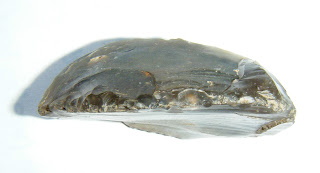Today I went to Bridport to help with a finds workshop led by my colleague Phil Clarke of Arrowhead Archaeology (look for his website under that name). He is organising a field walking project and wants any volunteers looking to help push it forward. It's all about local communities researching and surveying their local heritage and is a great chance for individuals to make a contribution to a greater knowledge of Dorset archaeology. As I always say, archaeology gives anyone, with some training and developing experience, the chance to discover a unique piece of the past for themselves. So here is a chance to touch the past, from hundreds or even thousands of years ago, in an area where no-one else has done so. If you wish to take part contact me and I will pass on your details.
To help in this regard here are some pointers to identifying flint artefact's. Worked flints are very hard to differentiate from natural flints for the untrained eye, so here are 4 indicators to look for when you come across this amazing material (not hard in Dorset).
1. The striking platform - where the flint has been prepared for the striking blow.
 |
| The platform is at the top |
2. The bulb of percussion - the bump where the blow has been struck.
3. The ripples - like in water these occur when the blow 'flows' through the flint.
 |
| Just like throwing a stone into a pond |
4. Retouch - where the maker is chipping the edge of the flint to make it sharper or serrated.
 |
| Chips but no fish |
Any or all of these means that it is more than likely been made by someone, sometimes thousands or even tens of thousands of years ago. And they can be just lying around on the surface of a field or path. Take any finds into the local museum and have them checked, just to make sure.
Best of luck, and as Shaw Taylor used to say "keep 'em peeled".
No comments:
Post a Comment